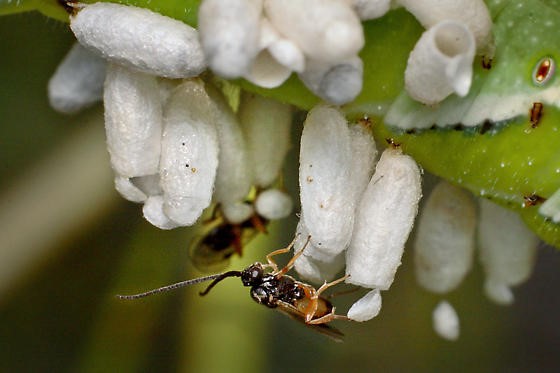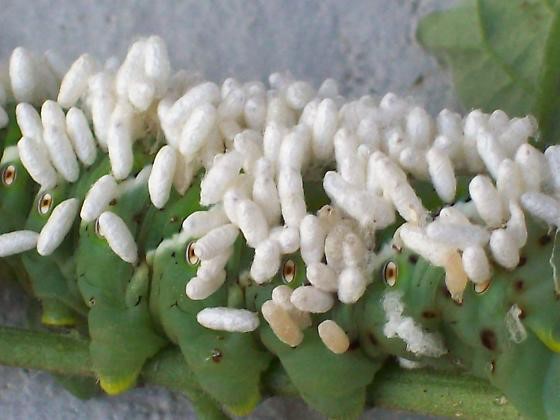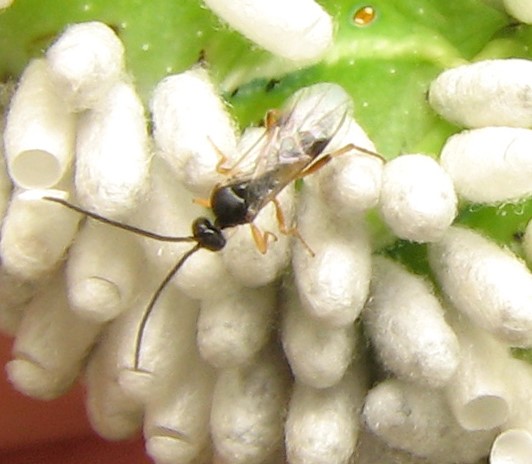Evolution Occurring Before Our Very Eyes: Parasitoids Diverging Based on Host’s Food Source Parasitic wasps, or parasitoids, lay their eggs inside other insects or animals, and their larvae feed on that insect or animal once they hatch. Many parasitoids lay their eggs in the larvae of other insects, for example caterpillars. Caterpillars often have adapted to feed on specific plants, called “host plants,” that may have chemical defensive properties (allelochemicals) that the caterpillars are able to cope with and sometimes incorporate in to their own chemical defenses. When parasitoids use these caterpillars as hosts, they too must adapt to the host plant’s toxins. These phenomena create a very interesting relationship between host plant, host insect, and parasitoid. The plant tries to defend against the host using toxins, the caterpillar incorporates and becomes immune to those toxins, and finally the parasitoids must adapt to the toxins present in the caterpillar host to guarantee its larvae can survive inside the host and eventually use it as food. Dr. Karen Kester received her PhD from the University of Maryland under the guidance of Dr. Pedro Barbosa researching the ability of parasitic wasps to adapt to the particular food plants and plant toxins of their insect hosts Parasitic wasps are a diverse group containing over 750,000 species, but the mechanisms of the group’s diversification are relatively unknown. Parasitic wasps are associated with a number of life history traits that can promote rapid adaptation to new hosts with specialized diets. These traits may have led to their incredible diversity. To test her hypotheses, Dr. Kester chose to focus on Cotesia congregata, a larval parasitoid of sphingid moths, including Manduca sexta caterpillars. These caterpillars have the ability to incorporate plant toxins into their own defense, for example the nicotine found in tobacco. Using field sites in multiple farms, and caterpillars feeding on either tomato or tobacco plants, she found that wasps localized to tomato-feeding caterpillars did poorly when made to parasitize tobacco-feeding caterpillars. On the other hand, wasps localized to tobacco fields had adapted to the nicotine toxins in the plants and the caterpillars and were able to cope with the toxicity. Dr. Kester determined that parasitoids can become genetically adapted to parasitize hosts found on locally abundant food plants (Barbosa et al, 1991; Kester & Barbosa, 1994). Dr. Kester went on to become a professor of Biology at the Virginia Commonwealth University where she has furthered her research on tritrophic interactions, first exploring Cotesia wasp adaptations to host – food plant complexes using both Manduca sexta and Ceratomia catalpae, important pests of tobacco and catalpa trees, respectively. Tobacco plants and catalpa trees differ in the types of chemicals they contain, and it was of interest to determine if these chemicals had any effect on the parasitoids of the two caterpillars. Dr. Kester determined that the wasps associated with tobacco-feeding caterpillars and catalpa-feeding caterpillars were genetically different, with a 2% sequence divergence in their mtDNA (Jensen et al, 2002; Kester et al, 2015). In fact, the genetic data revealed that the Cotesia wasps specializing on the two caterpillar types comprised two separate lineages with limited gene flow. This discovery raised additional questions regarding whether the two types of Cotesia could be considered different species, and led to another series of experiments. The primary question was if the differences were due to factors occurring before fertilization (prezygotic) or factors occurring after fertilization (postzygotic). Some prezygotic factors measured were the male response to female pheromones and male acoustic signals. Differential adaptations to host and food plants, as well as hybrid inviability are examples of some postzygotic factors that were explored. Hybrid inviability would occur if the two types Cotesia mated and had offspring that died before reaching adulthood. This would indicate that the two Cotesia wasps were so different that they could not successfully reproduce; this is called “reproductive isolation” and is an important part of the evolution of separate species. Results showed that fewer males responded to the pheromone from the “other” wasps compared to their own females. For example, wasps found to parasitize caterpillars feeding on tobacco were less likely to respond to pheromones of those parasitizing catalpa-feeding caterpillars (Bredlau, 2011; Bredlau & Kester, 2015). Dr. Kester also showed that the courtship songs between the two wasps also differed in duration and frequency, although no significant differences were detected in mating success (Bredlau et al, 2013). Although there were no differences in the success of different wasps mating, first-generation sibling crosses between progenies of two different wasps were discovered to be inviable. Dr. Kester’s current work investigates the underlying mechanisms causing this inviability. Recent discoveries have led her lab to believe the inviability in the first generation cross is related to the absence of polydnaviruses in the inviable offspring. Polydnaviruses are obligate symbiotic viruses that have coevolved with a subfamily of a group of Braconid parasitic wasps, including Dr. Kester’s target species Cotesia congregata (Albrecht et al, 1994; Savary et al, 1999). Ongoing research by Dr. Kester is exploring the evolutionary role of polydnaviruses as an underlying mechanism of speciation in wasps relative to changes in their host immune response. For instance, these viruses can lead to lateral gene transfer between wasp and host species, which may play an important role in the evolution of nicotine tolerance in the wasps associated with tobacco-feeding caterpillars. With the addition of viruses into this complex system, Dr. Kester now considers these species interactions to be “multi-trophic”. Dr. Kester’s final message was that, “once you know your system well, the questions never end.” She intends to further research differences in acoustic signals between different parasitic wasps, as well as look at other host – food plant complexes of Cotesia congregata. Dr. Kester’s work reminds us that evolution is occurring all around us and that new species are diverging right before our very eyes. References: Albrecht, U., Wyler, T., Pfister-Wilhelm, R., Gruber, A., Stettler, P., Heiniger, P., ... & Lanzrein, B. (1994). Polydnavirus of the parasitic wasp Chelonus inanitus (Braconidae): characterization, genome organization and time point of replication. The Journal of general virology, 75, 3353-3363. Barbosa, P., Gross, P., & Kemper, J. (1991). Influence of plant allelochemicals on the tobacco hornworm and its parasitoid, Cotesia congregata. Ecology, 1567-1575. Bredlau, J. (2011). Investigation of pre-and post-zygotic reproductive barriers between two host-plant complex races of the parasitic wasp Cotesia congregata (Say)[Hymenoptera: Braconidae]. Bredlau, J. P., Mohajer, Y. J., Cameron, T. M., Kester, K. M., & Fine, M. L. (2013). Characterization and generation of male courtship song in Cotesia congregata (Hymenoptera: Braconidae). PloS one, 8(4), e62051. Bredlau, J. P., & Kester, K. M. (2015). Pre-and Postzygotic Barriers to Reproduction Between Two Host-Foodplant Complex Sources of the Parasitic Wasp, Cotesia congregata (Hymenoptera: Braconidae). Annals of the Entomological Society of America, sav089. Jensen, K. M., Kester, K. M., Kankare, M., Brown, B. L. (2002) Characterization of microsatellite loci in the parasitoid, Cotesia congregata (Say) (Hymenoptera Braconidae). Molecular Ecology Resources. 2(3): 346-348. Kester, K. M., & Barbosa, P. (1994). Behavioral responses to host foodplants of two populations of the insect parasitoid Cotesia congregata (Say). Oecologia, 99(1-2), 151-157. Kester, K. M., Eldeib, G. M., & Brown, B. L. (2015). Genetic Differentiation of Two Host–Foodplant Complex Sources of Cotesia congregata (Hymenoptera: Braconidae). Annals of the Entomological Society of America, sav088. Savary, S., Drezen, J. M., Tan, F., Beckage, N. E., & Periquet, G. (1999). The excision of polydnavirus sequences from the genome of the wasp Cotesia congregata (Braconidae, Microgastrinae) is developmentally regulated but not strictly restricted to the ovaries in the adult. Insect molecular biology, 8(3), 319-327. About the Authors:
Grace Anderson is a Master’s student in the Sultz lab at UMD and works on the evolution of Harvestmen. She is currently exploring the morphological differences between closely related species that vary greatly in mating behavior. Veronica Johnson is a Master's student in the Hooks lab working with genetically modified corn. She is currently investigating the effects of different post-harvest practices on the persistence of toxic Bt proteins in senesced corn debris. Comments are closed.
|
Categories
All
Archives
June 2024
|
Department of Entomology
University of Maryland
4112 Plant Sciences Building
College Park, MD 20742-4454
USA
Telephone: 301.405.3911
Fax: 301.314.9290
University of Maryland
4112 Plant Sciences Building
College Park, MD 20742-4454
USA
Telephone: 301.405.3911
Fax: 301.314.9290




 RSS Feed
RSS Feed




